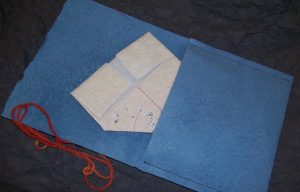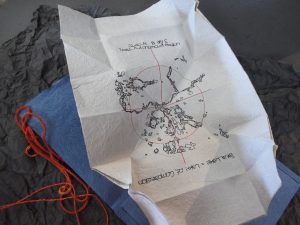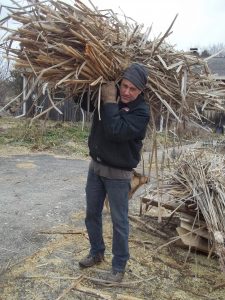“Paper as Textile” by Andrea Peterson
October 11, 2017
Artist and papermaker, Andrea Peterson, creates well-crafted and unique paper that continually pushes the material and medium forward in her Indiana studio. She was recently featured in Hand Papermaking magazine’s summer issue which focused on the use of paper as cloth and fabric.
One of the handmade papers I make at my studio, Hook Pottery Paper, is called momiINDIANA. As an admirer of momigami (the Japanese term for crinkled, kneaded paper), I always wondered how one could mimic that look and feel, instead using the inherent qualities of cotton rag. After a number of experiments over the years, I was able to finish this research by working with Maine artist, Katarina Weslien. Our paper is made of 100% cotton rag, beaten in a Hollander beater, made on an 18” x 24” mould, and pressed. Each damp sheet was scrunched into a ball and opened it back up, laying it flat in the open air to dry. Once dried, I burnished, starched, and ironed the sheets. The finish sheet resembles a wrinkled piece of cloth.

Andrea Peterson momiINDIANA 2017, cotton rag, 16.5″ x 22.5″.
Katarina Weslien and I crossed paths when she was trying to work out the details of her piece, Walking Kailash. I suggested to her the paper I was working on was a hybrid of cloth and paper—supple but not flimsy. The paper for this project needed to be functional in order to make a satchel and be aesthetically pleasing. Inside the satchel the same paper was folded as a map and embroidered with an exploded view of a microscopic drop of water from the Lake of Compassion in Tibet.

Katarina Weslien Walking Kailash 2017, paper and thread.

Katarina Weslien Walking Kailash 2017, paper and thread embroidered.
A sample of this paper is featured in Hand Papermaking magazine in the summer 2017 issue volume 32 which focused on the use of paper as cloth and fabric. Hand Papermaking is dedicated to advancing traditional and contemporary ideas in the art of hand papermaking in this particular issue there are many intersections between paper and textiles. Making textiles from paper is an incredible task since you must make the fiber into a sheet of paper first—like creating your own cloth—before you can create the textile itself. Many fibers are employed for this creative practice—cotton, flax, abaca and kozo are the most popular but the range can be wide.

Collecting cattails for papermaking, 2017.
I have had many artists and designers come and work with me in my studio in order to push the boundaries of the paper arts field. While working with German artist Melanie Theresa Bohrer, we discussed the translucent properties of abaca, a non-bearing banana plant. This fiber is incredibly translucent when beaten in a paper beater for a very long time. Melanie was very excited about the possibilities and the malleability of abaca. We succeeded to create a paper to have the qualities of organza and skin. The paper for these works becomes both skin and covering in sculptural and performance works.

Melanie Teresa Bohrer the aftermath of entanglement 2016, abaca fiber.
The sculpture and ritualistic objects she creates evoke the human form, explicitly referencing displacement and uncertainty of abstracted figures through scale, shape, and form. The abaca paper fiber works become body coverings that replicate the surface she is covering. The paper textile is a permeable membrane that has become wearable sculpture.

Melanie Teresa Bohrer the aftermath of entanglement 2016, abaca fiber.
– Andrea Peterson
Hand Papermaking is a biannual magazine published by Hand Papermaking, Inc., a not-for-profit organization dedicated to advancing traditional and contemporary ideas in the art of hand papermaking. Their current issue, “Textiles”, focuses on the use of paper as cloth and fabric. In addition to technical discussions of how paper has been used in the production of textiles, readers will hear from makers about the aesthetic, symbolic, and working properties of paper that make it a compelling material.



1 Comment
Berlinda Orji says
June 13, 2018 at 10:36 am
Good day It is really exciting to finally find an article that links textile production to paper because i have always wanted to see that possibility. Although i am presently in school trying to understand the engineering of some polymers to give me a wider knowledge of how long these processes might take. Thanks for this inspiration.
Related Blog Articles
No related blog articles yet.